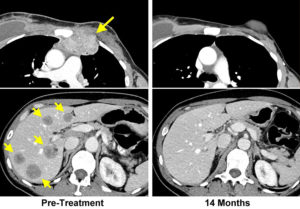
Left: CT scans of a woman with breast cancer before TIL therapy show a lesion invading the chest wall (top) and metastatic lesions in the liver (bottom). Right: Scans 14 months after treatment show all lesions have disappeared. Photo Credit: National Cancer Institute
“We’ve developed a high-throughput method to identify mutations present in a cancer that are recognized by the immune system,” Dr. Rosenberg said. “This research is experimental right now. But because this new approach to immunotherapy is dependent on mutations, not on cancer type, it is in a sense a blueprint we can use for the treatment of many types of cancer.”
The new immunotherapy approach is a modified form of adoptive cell transfer (ACT). ACT has been effective in treating melanoma, which has high levels of somatic, or acquired, mutations. However, it has been less effective with some common epithelial cancers, or cancers that start in the lining of organs, that have lower levels of mutations, such as stomach, esophageal, ovarian, and breast cancers.
In an ongoing phase 2 clinical trial, the investigators are developing a form of ACT that uses tumor-infiltrating lymphocytes (TILs) that specifically target tumor cell mutations to see if they can shrink tumors in patients with these common epithelial cancers. As with other forms of ACT, the selected TILs are grown to large numbers in the laboratory and are then infused back into the patient (who has in the meantime undergone treatment to deplete remaining lymphocytes) to create a stronger immune response against the tumor.
A patient with metastatic breast cancer came to the trial after receiving multiple treatments, including several chemotherapy and hormonal treatments, that had not stopped her cancer from progressing. To treat her, the researchers sequenced DNA and RNA from one of her tumors, as well as normal tissue to see which mutations were unique to her cancer, and identified 62 different mutations in her tumor cells.
The researchers then tested different TILs from the patient to find those that recognized one or more of these mutated proteins. TILs recognized four of the mutant proteins, and the TILs then were expanded and infused back into the patient. She was also given the checkpoint inhibitor pembrolizumab to prevent the possible inactivation of the infused T cells by factors in the tumor microenvironment.
After the treatment, all of this patient’s cancer disappeared
and has not returned more than 22 months later.
“This is an illustrative case report that highlights, once again, the power of immunotherapy,” said Tom Misteli, Ph.D., director of CCR at NCI. “If confirmed in a larger study, it promises to further extend the reach of this T-cell therapy to a broader spectrum of cancers.”
Investigators have seen similar results…
CLICK HERE TO CONTINUE READING
This article was originally posted on Cancer.gov.






